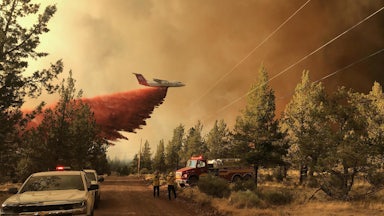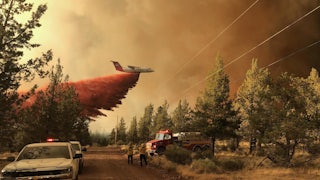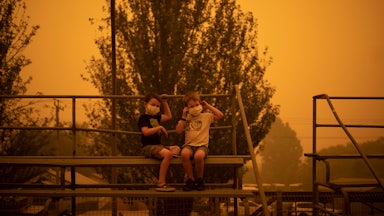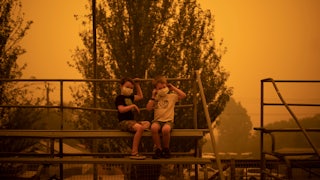“The year: 2022. The place: New York City. The population: 40,000,000.” The 1973 dystopian eco-thriller Soylent Green opened with these words. The film followed Detective Frank Thorn (Charlton Heston) around a dark, sweaty, food-scarce world ravaged by climate disaster as he investigated a murder and uncovered an even darker mystery: The main ingredient in the Soylent corporation’s nutritious green wafers, Thorn will soon learn, is people.
Despite mixed reviews (The New York Times called it “rarely convincingly real”), Soylent Green marked a turning point in depictions of the end of the world. Previously, apocalyptic movies focused on the distinctly Cold War threat of nuclear annihilation, from the dark comedy of Dr. Strangelove’s bomb to Godzilla’s irradiated reign of terror. Each new doomsday allowed people to “participate in the fantasy of living through one’s own death and more, the death of cities, the destruction of humanity itself,” Susan Sontag wrote in 1965. Toward the end of the twentieth century, however, other disaster fantasies started to creep in, including global warming. As the real world enters its Soylent Green year, Hollywood seems to have produced its most attention-grabbing climate change movie to date: Adam McKay’s Don’t Look Up, a star-studded affair that ranks among Netflix’s top-three debuts and has dominated the entertainment discourse. This time, people aren’t debating whether climate change itself is happening or really worth worrying about—but whether Don’t Look Up is any good.
Over the last half-century, climate change movies have inspired a range of emotions—when such films have been made at all. The silver screen of the 1980s was largely free of this environmental crisis, and when global warming returned with a vengeance in 1995’s Waterworld, its critique of the oil industry barely registered. The movie, like so many of its era, begins with the Universal logo spinning at the center of the screen, but this time, the ice sheets melt and the land recedes, until all that’s left is an endless sea, sparsely populated by a nameless human-fish mutant (Kevin Costner) and a Jet Ski gang living aboard the rusted-out remains of the Exxon Valdez oil tanker. While co-writer Peter Rader had plans for a more explicit environmental message, Costner reportedly wrestled for control to create a movie that was simply “exotic” and “cool.” Neither man got his way: When Waterworld debuted, its critics were most concerned with the behind-the-scenes drama.
A decade later, The Day After Tomorrow (2004) received almost the opposite treatment. The blockbuster begins at a United Nations–style climate summit, where paleoclimatologist Jack Hall (Dennis Quaid) warns world leaders that global warming will paradoxically trigger another Ice Age. The U.S. vice president—who at least one critic noted “bears a striking resemblance to Dick Cheney”—pushes back against Hall’s “sensationalist claims,” but the storm soon begins, encasing most of the northern hemisphere in ice and killing, presumably, a couple billion people. What follows is a fairly straightforward disaster film—Jurassic Park on ice—and a closing manifesto. “For years, we operated under the belief that we could continue consuming our planet’s natural resources without consequence,” the vice president, now a climate refugee in Mexico, admits on a Weather Channel–branded broadcast. “We were wrong. I was wrong.”
Despite criticisms of its heavy-handed script and dubious “science,” The Day After Tomorrow was a commercial success, which was precisely why critics fretted over it. “My fear [is] that, by presenting global warming in a laughably unrealistic way, the movie will only succeed in making audiences think that climate change is a big joke,” one critic wrote, in this magazine. While the film itself doesn’t seem to have dramatically altered individual viewers’ attitudes on climate change, it did become something of a political prop. NASA warned its scientists not to comment on the film publicly, while former Vice President Al Gore attended a climate rally at the American Museum of Natural History in New York to coincide with the movie’s release. (“There are two sets of fiction to deal with,” Gore said at the time. “One is the movie, the other is the Bush administration’s presentation of global warming.”) The result, Anthony Lane wrote in The New Yorker, is that “both sides of the environmental debate—those who are concerned by climate change and those who think that any such concern is a load of greenhouse gas—have been roused to action.”
To rewatch any of these movies, or reread the discourse that sprang up around them, is to peer through a shattered looking glass. The real 2022 is shaping up to be fractionally better than Soylent Green predicted. Last summer was the hottest on record, a mass extinction is well underway, and Covid-19 hospitalizations in the United States are surging once again, but humans are not routinely eating each other (as far as we know).
Perhaps that’s why many of the climate change movies of our time have forgone the action and adventure of postapocalyptic worlds and refocused on the psychological and spiritual experience of impending doom. No longer 50 or 500 years in the future, Downsizing (2015), Mother! (2017), First Reformed (2017), Woman at War (2018), and Don’t Look Up (2020) all show characters living in this dying world, right alongside the viewer. Climate change’s two timelines—one fictional, the other terrifyingly real—have converged. Characters and audiences are alternately despairing, angry, and hopeful about our future.
Viewers still vociferously debate the creative value and political utility of each new installment in our collective horror franchise. For most critics, Don’t Look Up failed on all fronts. The movie, which is both an allegory (it’s not climate change, it’s an asteroid!) and a political satire drawn directly from the headlines, has been widely criticized for its “wake-up-sheeple howl,” in the words of Rolling Stone, whose critic didn’t find the movie “funny, or insightful, or even watchable.” And “it’s hard to think about who, exactly, is going to be moved to make changes to how they live their lives by Don’t Look Up,” according to Vulture.
To be both hilarious and motivational is a tall order, but it’s the bar writer-director Adam McKay set for himself. Contrary to the critics’ opinions, a quarter-million IMDB star reviewers seem to think that McKay cleared it. The last act—smarter and more somber than the rest—may have even roused some of them to further action (including this writer, who walked out of the theater finally committed to dietary changes). But whatever one’s reaction to this latest climate film, at the very least, we’re talking about it.
For there’s a strong case to be made for a “more the merrier” mindset with “cli-fi” in every genre. We now live in a world that is “trans-apocalyptic,” as climate futurist Alex Steffen recently told Elizabeth Weil. “We’re in the middle of an ongoing crisis, or really a linked series of crises,” Weil elaborated, where our lives are increasingly “defined by ‘constant engagement with ecological realities,’ floods, dry wells, fires. And there’s no opting out. What does that even mean?” Art could help us find out. The more TV shows, books, and movies depicting climate change—and the more variety of climate consequences depicted—the better. But “the climate crisis is also a crisis of culture,” novelist Amitav Ghosh wrote in The Great Derangement in 2016, “and thus of the imagination.” While rage, even when repellent, and sadness, even when all-consuming, are worthy of representation, imagining a response to the crisis seems hardest of all.
In 2014, the science fiction writer Ursula K. Le Guin was awarded the National Book Foundation’s Medal for Distinguished Contribution to American Letters. “I think hard times are coming, when we will be wanting the voices of writers who can see alternatives to how we live now, and can see through our fear-stricken society and its obsessive technologies, to other ways of being,” she said in her acceptance speech. “And even imagine some real grounds for hope.” Two years into the climate’s “decisive decade,” that real, hard hope—a hope rooted in action, not magical thinking, with all the compromises and attendant details—is still largely missing. Where is the marriage plot set in a carbon-regulating city that successfully retreated from the fire lines, or the gangster film about organized crime in renewable energy? The sitcom about a family whose full house is on stilts above the waterline, or the Wall Street movie about emissions pricing?
Perhaps the closest thing we have is Woman at War, an Icelandic film about Halla (Halldóra Geirharðsdóttir) a choir director who moonlights as an industrial saboteur, strategically disrupting the local aluminum plant. While it’s set in our extended pre-apocalyptic present, the movie, equal parts puckish and poignant, pushes the conversation forward. When Halla finally gets the chance to adopt a child—a little Ukrainian girl orphaned in a war—she is forced to weigh her risky environmental commitments, all aimed at a better future, against the responsibility of caring for another human being in the here and now. Though there is a twist that shouldn’t be spoiled, Halla ultimately chooses the child. In the last scene of the movie, when their bus flounders in a flood somewhere in Eastern Europe, Halla carries her daughter above the waterline, slowly wading toward the nearest shore. As the folk music swells, the challenges they face are clear, but it’s like Halla’s own mother always said: Finna lausnir. Find solutions.








